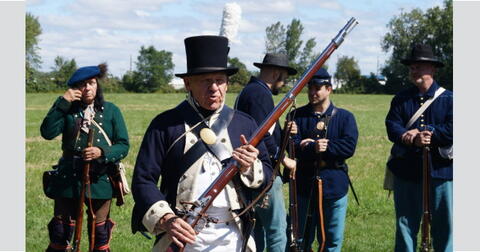Monroe Battlefield Group Using Modern Social Justice Framing To Tell Story Of Native American Mistreatment
And millions of tax dollars heading their way
Officials of the River Raisin National Battlefield Foundation in Monroe hope the $100 million park project they’ve proposed at a site where American soldiers were slaughtered in the War of 1812 will draw as many visitors each year as Gettysburg.
The money will come from both taxpayers and private contributors. The project also includes a $20 million educational center housed in a former sports complex facility.
To put the $100 million price in perspective, from 1812, when that war began, until its end in 1815, the U.S. national debt grew from $45.2 million to $119.2 million, according to debt.org.
The state of Michigan has already contributed $6.8 million to the Monroe project. The federal government will add another $2 million to $4 million according to 13 ABC Action News. It is not known whether more state and federal dollars will follow.
The city of Monroe has approved spending nearly $90,000 in local tax money on architectural plans for the project, according to the Monroe News. The Monroe City Council has not responded to questions Michigan Capitol Confidential emailed about other city spending related to the park.
The battle and massacre took place in 1813 at Frenchtown, which is now the city of Monroe. Almost 1,000 U.S. soldiers were killed or captured by the British and Canadian force and the Native Nation Confederation. The American dead could not be buried due to threats from Native Americans, according to the foundation’s website.
The foundation’s website says the education center will teach, among other objectives, how to identify racism and propaganda, in an effort to prevent abuse of power, genocide, and forced assimilation. It will also educate visitors on “confronting humanity in the world today including unchecked power, colonization, refugees, and race-based societies.”
Plans for a park include a recreation of Frenchtown with period houses, barns, a trading post, and vineyards from the time of the war.
Comparisons with the Battle of Gettysburg in July of 1863 appear to be a stretch. Coming 50 years after River Raisin, it was bloodiest battle of the Civil War, and the spot where President Abraham Lincoln delivered the Gettysburg Address, which has defined the meaning of that conflict ever since. The American Battlefields Trust reports Gettysburg has received between 1 million and 2 million visitors every year since the 1980s, and the local economy receives $92 million annually in benefits.
Boosters say they anticipate the River Raisin National Battlefield will draw more than one million visitors annually. It had 239,000 visitors in 2017 according to Crain’s Detroit Business.
The park is owned by the National Park Service, which gave it the national battlefield designation in 2011.
Michigan Capitol Confidential is the news source produced by the Mackinac Center for Public Policy. Michigan Capitol Confidential reports with a free-market news perspective.

